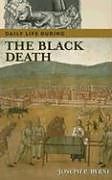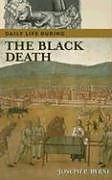Daily Life During the Black Death
Einband:
Fester Einband
EAN:
9780313332975
Untertitel:
Englisch
Autor:
Joseph P. Ph. D. Byrne
Herausgeber:
Greenwood
Anzahl Seiten:
340
Erscheinungsdatum:
01.07.2006
ISBN:
0313332975
Informationen zum Autor JOSEPH P. BYRNE is a European historian and Associate Professor of Honors at Belmont University, Nashville, TN. He has conducted research and published articles on a wide variety of subjects, from Roman catacombs to American urbanization, though his area of expertise is Italy in the era of the Black Death. He is the author of The Black Death (Greenwood, 2004) and Daily Life during the Black Death (Greenwood, 2006). He is currently serving as editor for The Encyclopedia of Plague, Pestilence and Pandemic (Greenwood, projected 2008). Klappentext Daily life during the Black Death was anything but normal. When plague hit a community, every aspect of life was turned upside down, from relations within families to its social, political, and economic stucture. Theaters emptied, graveyards filled, and the streets were ruled by the terrible corpse-bearers whose wagons of death rumbled day and night.Daily life during the Black Death was anything but normal. During the three and a half centuries that constituted the Second Pandemic of Bubonic Plague, from 1348 to 1722, Europeans were regularly assaulted by epidemics that mowed them down like a reaper's scythe. When plague hit a community, every aspect of life was turned upside down, from relations within families to its social, political and economic structure. Theaters emptied, graveyards filled, and the streets were ruled by terrible corpse-bearers whose wagons of death rumbled night and day. Plague time elicited the most heroic and inhuman behavior imaginable. And yet Western Civilization survived to undergo the Renaissance, Reformation, Scientific Revolution, and early Enlightenment.In Daily Life during the Black Death Joseph Byrne opens with an outline of the course of the Second Pandemic, the causes and nature of bubonic plague, and the recent revisionist view of what the Black Death really was. He presents the phenomenon of plague thematically by focusing on the places people lived and worked and confronted their horrors: the home, the church and cemetary, the village, the pest houses, the streets and roads. He leads readers to the medical school classroom where the false theories of plague were taught, through the careers of doctors who futiley treated victims, to the council chambers of city hall where civic leaders agonized over ways to prevent and then treat the pestilence. He discusses the medicines, prayers, literature, special clothing, art, burial practices, and crime that plague spawned. Byrne draws vivid examples from across both Europe and the period, and presents the words of witnesses and victims themselves wherever possible. He ends with a close discussion of the plague at Marseille (1720-22), the last major plague in northern Europe, and the research breakthroughs at the end of the nineteenth century that finally defeated bubonic plague. Zusammenfassung He ends with a close discussion of the plague at Marseille (1720-22)! the last major plague in northern Europe! and the research breakthroughs at the end of the nineteenth century that finally defeated bubonic plague. Inhaltsverzeichnis ChronologyThe Black Death: 1347-1730At Medical SchoolAt the Doctor's OfficeAt Home with the PlagueAt the Churh and ChurchyardIn the BIshop's Palace and MonasteryAt the Pest HouseAt City HallOn the Steets and Roads of EuropeAt the Booksellers and the TheatreIn the Village and on the ManorIn the Medieval Muslim WorldThe Plague's Last Stand in EuropeBibliographyIndex...
Autorentext
Joseph P. Byrne, PhD, is professor of honors humanities at Belmont University in Nashville, TN.
Klappentext
Daily life during the Black Death was anything but normal. When plague hit a community, every aspect of life was turned upside down, from relations within families to its social, political, and economic stucture. Theaters emptied, graveyards filled, and the streets were ruled by the terrible corpse-bearers whose wagons of death rumbled day and night. Daily life during the Black Death was anything but normal. During the three and a half centuries that constituted the Second Pandemic of Bubonic Plague, from 1348 to 1722, Europeans were regularly assaulted by epidemics that mowed them down like a reaper's scythe. When plague hit a community, every aspect of life was turned upside down, from relations within families to its social, political and economic structure. Theaters emptied, graveyards filled, and the streets were ruled by terrible corpse-bearers whose wagons of death rumbled night and day. Plague time elicited the most heroic and inhuman behavior imaginable. And yet Western Civilization survived to undergo the Renaissance, Reformation, Scientific Revolution, and early Enlightenment. In Daily Life during the Black Death Joseph Byrne opens with an outline of the course of the Second Pandemic, the causes and nature of bubonic plague, and the recent revisionist view of what the Black Death really was. He presents the phenomenon of plague thematically by focusing on the places people lived and worked and confronted their horrors: the home, the church and cemetary, the village, the pest houses, the streets and roads. He leads readers to the medical school classroom where the false theories of plague were taught, through the careers of doctors who futiley treated victims, to the council chambers of city hall where civic leaders agonized over ways to prevent and then treat the pestilence. He discusses the medicines, prayers, literature, special clothing, art, burial practices, and crime that plague spawned. Byrne draws vivid examples from across both Europe and the period, and presents the words of witnesses and victims themselves wherever possible. He ends with a close discussion of the plague at Marseille (1720-22), the last major plague in northern Europe, and the research breakthroughs at the end of the nineteenth century that finally defeated bubonic plague.
Zusammenfassung
He ends with a close discussion of the plague at Marseille (1720-22), the last major plague in northern Europe, and the research breakthroughs at the end of the nineteenth century that finally defeated bubonic plague.
Inhalt
Chronology The Black Death: 1347-1730 At Medical School At the Doctor's Office At Home with the Plague At the Churh and Churchyard In the BIshop's Palace and Monastery At the Pest House At City Hall On the Steets and Roads of Europe At the Booksellers and the Theatre In the Village and on the Manor In the Medieval Muslim World The Plague's Last Stand in Europe Bibliography Index

Leider konnten wir für diesen Artikel keine Preise ermitteln ...
billigbuch.ch sucht jetzt für Sie die besten Angebote ...
Die aktuellen Verkaufspreise von 6 Onlineshops werden in Realtime abgefragt.
Sie können das gewünschte Produkt anschliessend direkt beim Anbieter Ihrer Wahl bestellen.
Loading...
Die aktuellen Verkaufspreise von 6 Onlineshops werden in Realtime abgefragt.
Sie können das gewünschte Produkt anschliessend direkt beim Anbieter Ihrer Wahl bestellen.
| # | Onlineshop | Preis CHF | Versand CHF | Total CHF | ||
|---|---|---|---|---|---|---|
| 1 | Seller | 0.00 | 0.00 | 0.00 |
